In today’s world, it is not enough to simply balance the cost of doing business against revenue and focus on profitability and return on investment alone.
What you need to do is consider social and environmental responsibility in your bottom-line calculation and take a more holistic approach to measure your company’s impact locally and globally.
That means taking actions that:
- generate public goodwill
- enhance your image and reputation
- attract talented employees
- promote greater awareness of the environmental impact
- offer a competitive advantage
Or, to put it simply, apply the TBL approach to your business.
The TBL Defined
TBL relates to the last line on a balance sheet that measures profit or loss. It focuses on three areas of impact:
People: refers to a company’s social responsibility, both in the workplace and community.
Planet: refers to business practices that reduce an enterprise’s environmental footprint.
Profit: refers to traditional reporting of costs.
Applying TBL method of tracking sustainability and not making it all about profits has transformed the way businesses measure performance.
You don’t have to only take our word for it.
According to the UN World Commission on Environment and Development, sustainable development, which is based on Triple Bottom Line, satisfies the needs of the present generation without jeopardizing the ability of future generations to satisfy theirs.
The three basic dimensions of sustainable development are:
Social: improvement in the living conditions and safety of all people.
Ecological: protection of the environment and its natural resources.
Economic: economic development that is not hindered, but stimulated by technological advancement and increased effectiveness in the use of resources, materials and workforce.
Such development is intelligent, environmentally friendly, and based on the effective use of resources, knowledge, and innovation.
If you want to hear (even) more good news about the TBL approach, there is some additional research showing that consumers are willing to pay more for services and goods from businesses that commit to sustainable practices.
In case you are still not convinced about the benefits of doing well by doing good, here are some stats to prove the point: today, nearly 90% of Gen X consumers said that they would be willing to spend an extra 10% or more for sustainable products, compared to just over 34% two years ago.
Instilling a philosophy of sustainability into your company culture is here to stay. And it is a fast-track to attracting forward-thinking customers, recruiting young talent, and keeping your shareholders and stakeholders happy.
However, sustainable companies should not only be concerned about Corporate Social Responsibility (CSR) and philanthropy. They should start with treating their employees well, developing them and creating a better life for them and their families.
TBL helps companies to commit to people, communities, and environmental concerns just as they do to profits. Hence, it’s time for leaders to articulate how the firm creates value for all stakeholders, not just shareholders, and accept that profit is the outcome of this value creation.
G&A Institute research states that 9 out of 10 companies (90%) in the S&P 500 have published a sustainability report. This consistent volume of corporate reporting underscores the importance and staying power of sustainable practices and their reporting.
Creating TBL performance indicators when setting corporate strategies is among the first steps towards creating a sustainable and successful business that attracts people to work with them, buy from them, and invest in them.
TBL goals can bring you market differentiation, reduce your risk, improve stakeholder relationships, and finally improve productivity and profitability.
Over the past five years, companies like Unilever, Tesla, Chipotle, Ikea, Nike, and Whole Foods became the billion-dollar companies driving their profits from sustainability alone.
What have they done right? They have focused on their People, Profit and Planet.
You may think that the TBL may be a complex undertaking as it requires a company-wide adoption to bring the desired results.
And you have every right to do so.
This is why we have created a series of blogs dedicated to help you get familiar with the TBL approach to see why and how it works.
We are going to start with People, because they should sit at the heart of every organization.
Stay tuned.
Edited by: Izabela Hamilton






